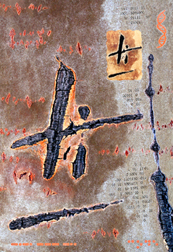I’m currently an invited artist in Binary Inventions: Art and Culture in the Digital Age, in conjunction with a UND Art Department conference on the same subject. The show is at Third Street Gallery in Grand Forks – Oct 5 – 26, 2012.
The title Binary Inventions intrigued me. My digital print with solarplate – Arborglyph: (1 symbol 30) Code, contains hints of various codes; plus/minus as in my Arborglyph symbol, binary code (0110100), genetic code, Morse code, and Braille code. They are all forms of messaging or communication. Code is “a rule for converting a piece of information into another form or representation”.
A binary system involves only two choices: 0 or 1, yes or no, true or false, on or off switch in electronics, and plus or minus. Despite how simple this all sounds, very complicated things happen because of codes. For instance, it was recently discovered that the human genome has 4 million on/off switches that tell our genes what to do. Also, the use of the computer and the internet has changed our lives immensely in the last years. We can send messages globally in seconds. And we can record photographs and videos digitally instead of on film. In terms of size, the aspen clone, Pando, is believed to be the world’s most massive organism. The aspen’s form of reproduction is cloning (by genetic code). And aspen tree bark markings are the impetus for my Arborglyph images.
Code often lies below the surface where we can’t see it; as in computer language, electronic switches, or genetics. Code is found in nature and in man-made entities. It can be common knowledge or secret. Code is everywhere!
 BINARY CODE: Binary is a two-digit numerical system in which computers store data and compute functions. Computers use the binary system because digital switches inside the computer can only be set to ON or OFF, which are represented by 1 or 0. In computer science, a code is considered as an algorithm which uniquely represents symbols from a source alphabet by encoded strings. ASCII uses a 7 bit binary code to represent text within a computer… 0100101 0111010
BINARY CODE: Binary is a two-digit numerical system in which computers store data and compute functions. Computers use the binary system because digital switches inside the computer can only be set to ON or OFF, which are represented by 1 or 0. In computer science, a code is considered as an algorithm which uniquely represents symbols from a source alphabet by encoded strings. ASCII uses a 7 bit binary code to represent text within a computer… 0100101 0111010
![]() GENETIC CODE: The genetic code is based on sets of nucleoside base pairs called “codons”. Codons transcribe and translate genetic traits from DNA to RNA and RNA to proteins. New findings reveal that the human genome has 4 million + on/off switches that tell our genes what to do.
GENETIC CODE: The genetic code is based on sets of nucleoside base pairs called “codons”. Codons transcribe and translate genetic traits from DNA to RNA and RNA to proteins. New findings reveal that the human genome has 4 million + on/off switches that tell our genes what to do.
![]() MORSE CODE: Morse Code transmits text by a series of on/off tones, lights, or clicks to commute a message.
MORSE CODE: Morse Code transmits text by a series of on/off tones, lights, or clicks to commute a message.
![]() BRAILLE CODE: Braille is a binary encoding scheme that represents the characters of writing for the blind that is done in a series of 6 dots.
BRAILLE CODE: Braille is a binary encoding scheme that represents the characters of writing for the blind that is done in a series of 6 dots.

Leave a Reply